- within Antitrust/Competition Law topic(s)
- with readers working within the Healthcare industries
On March 12, the U.S. Department of Homeland Security (DHS) published its proposed new registration Interim Final Regulation (IFR).1 It becomes effective on April 11, 2025. The IFR outlines the existing long-term regulations that provide that it is a legal requirement for all unregistered foreign nationals (or previously registered foreign nationals who turn 14 years old) who are in the United States (U.S.) for thirty (30 days) or longer to comply with these requirements. "Failure to comply may result in criminal and civil penalties, up to and including misdemeanor prosecution, the imposition of fines, and incarceration."2
The IFR notes that other than foreign nationals present in the U.S. without inspection and admission or inspection and parole who have not been registered, Canadian visitors who entered the U.S. at land ports of entry (POEs) and were not issued an I-94 (evidence of registration) will be the larger populations affected by this regulatory change. This posting did not reference the acceptance of the admission stamp in a foreign passport with the class of admission, admission date, and admit until date as acceptable registration evidence, but it is noted in the IFR as acceptable proof of registration. The challenge is that passport entry stamps are becoming extinct in the U.S. It is important to remember that not all Canadian visa-exempt B visitors may be issued an I-94 upon request for admission to the U.S. Often, they may be waived into the U.S at a POE, and no I-94 is generated in the CBP system.
Why are they making this land admission reference for Canadian visa-exempt visitors? This distinction is made because Canadian visitors (equivalent to B-1 business visitors and B-2 tourists) entering the U.S. via air and sea (except via ferry) are charged a fee to generate an I-94 admission record as a part of their ticket. In addition, U.S. Customs and Border Protection (CBP) no longer requires travellers entering the U.S. via air or sea (ferry admissions are similar to land POE admissions) to complete a paper I-94.3 The electronic I-94 available on the CBP website here is the equivalent of a paper I-94 to serve as documentation of registration.4
As to the use of a passport stamp in a foreign passport, the option has been practically phased out due to the implementation of Simplified Arrival and Stampless Entry by CBP. In fact, CBP officers may refuse the request.5 Whether this option (passport stamp on entry with the required data) is available depends on the land border port of entry.6
What should visa-exempt Canadian visitors do when entering the U.S. for a business visit or tourism via ferry or land?
- If you plan to remain in the U.S. for thirty (30) days or more, request an I-94 admission record from the CBP officer and then make sure it was issued by checking the CBP website here. Even if you do not plan to remain in the for thirty (30) days or more, in light of the possibility of arrest for failure to carry your registration document (e.g., I-94) by mistake and the inability to prove your date of entry at the land border, it may be advisable to obtain an I-94. The other option is to attempt to request a passport entry stamp with the correct date (admission date, admission category, and admit until date).
- Consider requesting a provisional I-94 in advance of your land border admission date online or via the CBP Home Mobile application. You will need to be planning to appear within seven days at the POE to use this option and pay the $6.00 fee in advance. This payment does not guarantee admission.
- If you are a Canadian visitor who entered the U.S. when you were under fourteen (14) and you turn fourteen (14) during your visit to the U.S., then a registration requirement is triggered to be completed within thirty (30) days after your fourteenth (14th ) birthday.
- Print out the I-94 record from the CBP website to retain in your possession while in the U.S.
- Don't forget the obligation to notify USCIS of a change in address within ten (10) days of a change while in the U.S. using the AR-11 form, which may be submitted via a USCIS online account or via mail.7
- If you did not obtain an I-94 or passport admission stamp with the correct data, then consider creating a myUSCIS account 8 to complete the G-325R form online and keep a copy of the issued certificate of registration on your person.9 Another option is to depart the U.S. and reenter to complete your visit with an I-94 online printout in hand or a passport entry stamp with the correct data.
What are the penalties for failure to register, carry registration documents, or failure to provide a change of address timely?
| Offense | Fine | Imprisonment/Removal |
| Willful failure or refusal to register | Up to $5,000.00 | Imprisonment up to six (6) months or both |
| Willful failure to provide change of address notice timely | Up to $5,000.00 | Imprisonment up to thirty (30) days or both, and removal from the U.S., if failure not reasonably excusable or was not willful |
| Failure to carry and have in personal possession at all times, if 18 years of age or older, a certificate of alien registration or alien registration receipt | Up to $5,000.00 | Imprisonment up to thirty (30) days or both |
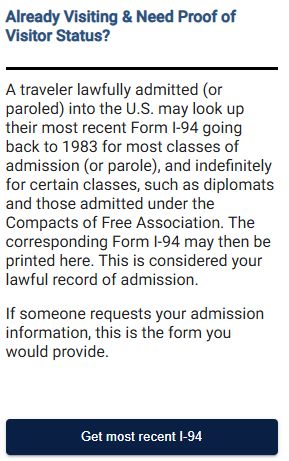
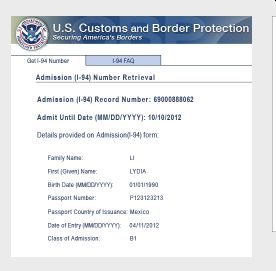
What is the registration application process?
- Create a unique myUSCIS account or an account for a child, as applicable here.
- Complete G-325R form online, which is free of charge at the moment.
- Submit the G-325 form online.
- Review the account for biometrics services appointments at a USCIS Application Support Center (ASC). At the appointment, fingerprints, a photograph, and a signature will be required. (It is expected that this ASC biometric intake appointment will eventually require a fee of $30.00.)
- USCIS will use this information to check criminal history records maintained by the Federal Bureau of Investigation (FBI).
- After the ASC appointment, the ELIS case management system will produce a "Proof of Alien Registration" form with a unique designated identifier. For those required to register but for whom a fingerprint is waived, such as Canadian nonimmigrants under the age of 14, the ELIS case management system will issue the "Proof of Alien Registration" form upon receipt of the Form G-325R online.
- The Proof of Alien Registration is posted to the foreign national's myUSCIS account.
- The foreign national downloads a .pdf version of the certificate to print and use as evidence of registration, which must be carried at all times in the personal possession of the foreign national while in the U.S.
Checklist for Canadian Visitors – April 11, 2025 Registration
- Are you entering the U.S. by air/sea or land/ferry? If entering by land or ferry, you need to consider registration. Note that none of the trusted traveller programs issue a document meeting the registration requirements.
- Are you planning to remain in the U.S. for thirty (30) days or more if entering the U.S. by land or ferry? If so, you need to have an I-94 admission record, an admission stamp in your passport including your admission date, admission category, and "admit until date" from CBP, or consider using the new online G-325R registration process. Note that CBP may provide each traveler with an admission stamp that is annotated with the date of admission, class of admission, and admit until date. CBP is not required to issue an admission stamp. The online G-325R process requires far more information than an I-94 admission record. Please note that CBP has practically eliminated the use of admission stamps and transitioned to the use of the I-94 online and the use of facial recognition technology. Review the Simplified Arrival program here.
- If you wish to reduce the processing steps to obtain an I-94 for your land border entry to the U.S., you may download the CBP Home mobile app or go to the CBP I-94 website10 to complete a provisional I-94 application within seven days of your intended application for entry to the U.S. You may also pay the $6.00 application fee in advance through the app or website. The use of the provisional I-94 process does not guarantee admission, but it does expedite the steps at the land border to be considered for admission.11 Note that the default admission period for an I-94 issued to a tourist at the land border is six months for multiple entries. The I-94 issued for air admissions, however, has a default period of admission that is the same for visitors at the land border. Visitors arriving at an airport are limited to a single entry I-94 to the U.S. unless designated otherwise by the CBP officer. At present, CBP is testing the use of the CBP Home app to report timely departures in compliance with the I-94.12
- In order to comply with the requirement to keep the I-94 record in your possession during your visit to the U.S., you must print out a copy of the I-94 record from the website. While you could download a copy of the I-94 on your CBP Home app or on your phone, CBP has not indicated that a downloaded scan on your phone will comply with the registration requirement. In an emergency, you can try to use a download of the I-94 as your home screen and lock your phone. Of course, CBP officers may request that you unlock your phone, and if you refuse to do so, it could result in your refusal to be admitted to the U.S.13 Again, another option should be the use of an admission stamp in your passport that includes the date of admission, class of admission, and "admit until date." If the stamp does not contain all of these elements, it may not be acceptable proof.
- If the CBP officer is deciding not to grant your admission to the U.S., always first request that you withdraw your application for admission. The CBP officer can use expedited removal to refuse your admission because they believe you misrepresented a material fact (e.g., your true intent for your visit) or that you intend to immigrate to the U.S. versus visit (e.g., intent to live in the U.S.).
- The failure to timely depart the U.S. can impact your future
ability to enter the U.S. It is possible to report a timely
departure by the land border by (a) stopping at a land border and
presenting a printed copy of the electronic I-94 to the CBP
officer; (b) stopping at a land border port of entry and placing a
printed copy of the electronic I-94 form in a drop box provided by
the port, if available; or (3), if exiting by land on the northern
U.S. border, by providing a printed copy of the electronic I-94
form to the Canadian Border Services Agency (CBSA) when entering
Canada CBSA will then return the form to CBP).14
Remember that visitors are not allowed to "work" in the
U.S. or to "live" in the U.S. Both terms are subject to
interpretation, but work in the U.S. is defined as any services for
basically any remuneration, including housing or food, for
example.
Captains of pleasure boats are not required to report information regarding parties on the boat to CBP upon departure from the U.S. Pilots of private aircraft are required to submit a manifest, but there is limited capture travelers' biometrics. Both pleasure boats and private aircraft are permitted to depart the U.S. from any location, including private property; therefore, most of these exits are not reported to CBP. CBP posted information about a Voluntary Self-Reported Exit (VSRE) pilot on March 19, 2025.15 CBP will conduct the VSRE pilot for two (2) years starting on March 19, and it is a voluntary program. It is critical to report timely departure from the U.S. within the validity period of the I-94 admission record to avoid potential future admissibility to the U.S. due to an unexcused overstay. The pilot requires the foreign national to submit a live image (Selfie) via the CBP Home app, along with the photo and biographical information from their admission documents, which are also stored via the CBP Home app.
Departures by visitors via air after a land border admission should be traceable using the travel history posted by CBP on its I-94 website or by CBSA's travel history.16 It is important to review your travel history records to confirm that your departure was recorded as timely (e.g., with the I-94 admission period)
- If a Canadian visitor or nonimmigrant enters the U.S. when under the age of fourteen (14), but will turn fourteen (14) years of age while in the U.S., then their parent or guardian must consider leaving the U.S. or complying with the registration requirement by submitted the G-325R form online. Although the Canadian visitor will be exempt from the fingerprinting requirement, the submission of the G-325R will result in the creation of the "Proof of Alien Registration Form" to download and print from the foreign national's myUSCIS.account.
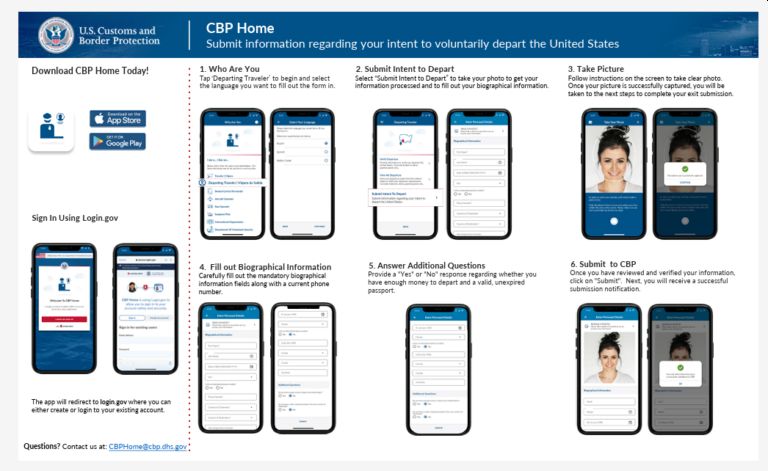
CBP Tear Sheet – Border Search of Electronic Devices https://www.cbp.gov/travel/cbp-search-authority/border-search-electronic-devices
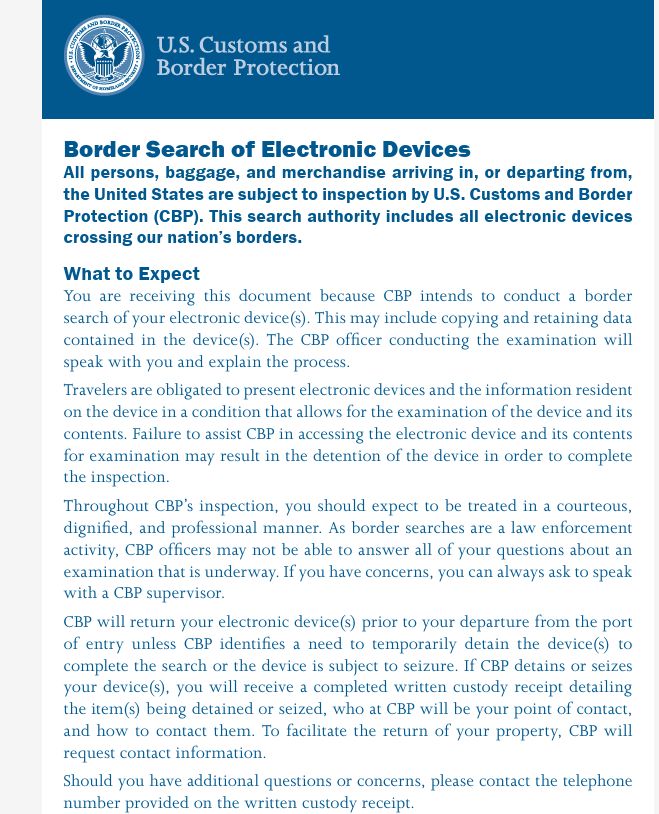
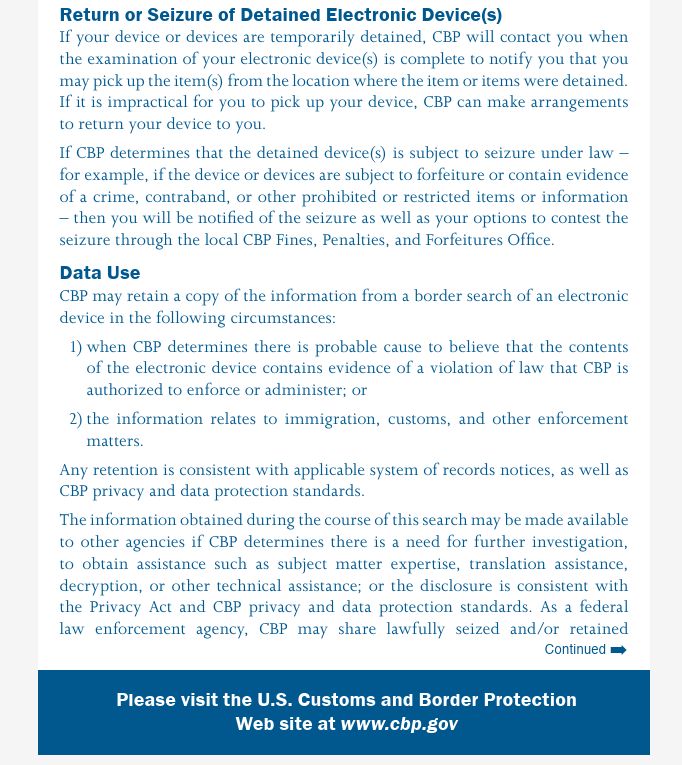
THE G-325R QUESTIONS
- Current Legal Name
- Contact Information (mailing or safe address) – Is the current mailing address the same as your physical address?
- Physical Address – length of time at address
- Address History for past 5 years
- Immigration Information:
- Last Arrival in U.S.
- I-94 Admission Record Number
- Expiration Date of I-94
- Activities engaged in since I-94 entry date
- Activities intend to engage in from now to departure from the U.S.
- How long will you remain in the U.S.
- What is your expected date of departure
- What is your A# and USCIS Online Account Number
- Biographic Information
- Sex
- Ethnicity
- Race
- Height
- Weight
- Eye Color
- Hair Color
- Police/Criminal Record (If you answer Yes to any questions
below, explain)
- Have you EVER been arrested, cited, charged, or permitted to participate in a diversion program (including pre-trial diversion, deferred prosecution, deferred adjudication, or any withheld adjudication), or detained for any reason by any law enforcement official in any country, including but not limited to any U.S. immigration official or any official of the U.S. armed forces or U.S. Coast Guard or by a similar official of a country other than the United States?
- Have you EVER committed a crime of any kind (even if you were not arrested, cited, charged with, tried for that crime, or convicted)?
- Have you EVER pled guilty to or been convicted of a crime or offense (even if the violation was subsequently expunged or sealed by a court, or if you were granted a pardon, amnesty, a rehabilitation decree, or other act of clemency)?
- Have you EVER been ordered punished by a judge or had conditions imposed on you that restrained your liberty (such as a prison sentence, suspended sentence, house arrest, parole, alternative sentencing, drug or alcohol treatment, rehabilitative programs or classes, probation, or community service)?
- Have you EVER violated (or attempted or conspired to violate) any controlled substance law or regulation of a state, the United States, or a foreign country?
Family Information
- Are you currently married? What is your husband or wife's current legal name?
- What is your husband or wife's date of birth?
- What is your husband or wife's city of birth?
- What is your husband or wife's country of birth?
- When did you marry your husband or wife?
- Where were you married?
- What is your father's name?
- What is your father's date of birth?
- What is your father's city or town of birth? (if known)
- What is your father's country of birth? (if known)
- What is your father's current city or town of residence? (if living)
- What is your father's current country of residence? (if living)
- What is your mother's name?
- What is your mother's date of birth?
- What is your mother's city or town of birth? (if known)
- What is your mother's country of birth? (if known)
- What is your mother's current city or town of residence? (if living)
- What is your mother's current country of residence? (if living)
Upload any additional evidence or documents you want to provide that help explain any of your responses on the form, such as:
- Representation – If you are currently represented by an attorney or accredited representative, you may upload a completed and signed Form G-28, Notice of Entry of Appearance of Attorney or Accredited Representative.
- Criminal History – You may, if you choose, submit certified police and court records for any criminal charges, arrests, or convictions you may have, as well as any evidence of a pardon, amnesty, rehabilitation decree, or other act of clemency.
- Other Supporting Documentation – You may submit any additional documents to support your registration or provide an explanation for any information contained in your form.
I certify, under penalty of perjury, that I provided or
authorized all of the responses and information contained in and
submitted with my {form Type}, I read and understand or, if
interpreted to me in a language in which I am fluent by the
interpreter listed in Getting Started, understood, all of the
responses and information contained in, and submitted with, my
{form Type}, and that all of the responses and the information are
complete, true, and correct.
I understand that USCIS will require me to appear for an
appointment to take my biometrics (fingerprints, photograph, and/or
signature) and, at that time, I will be required to sign an oath
reaffirming that:
- I reviewed and provided or authorized all of the information in my {form Type} ;
- I understood all of the information contained in, and submitted with, my {form Type}; and
- All of this information was complete, true, and correct at the time of filing.
Furthermore, I authorize the release of any information from any of my records that USCIS may need to determine my eligibility for an immigration request and to other entities and persons where necessary for the administration and enforcement of U.S. immigration law.
Footnotes
1. See 90 Fed. Reg. 11793 (March 12, 2025).
2. Id.
3. See 87 Fed. Reg. 15446 (March 18, 2022).
4. See 78 Fed. Reg.18457 (March 27, 2013) and definition of I-94 at 8 CFR part 1.
6. See https://www.help.cbp.gov/s/article/Article-1708?language=en_US, and https://epic.org/wp-content/uploads/foia/dhs/cbp/biometric-entry-exit-alt-screening-procedures/CBP-and-SimplifiedTravel-Info-and-FactSheet.pdf .
7. See https://www.uscis.gov/ar-11 .
8. See https://my.uscis.gov/.
9. See https://www.uscis.gov/g-325r .
10. See https://i94.cbp.dhs.gov/home .
11. See https://www.cbp.gov/newsroom/local-media-release/use-cbp-home-comfort-home-your-provisional-i-94 .
12. Seehttps://www.cbp.gov/about/mobile-apps-directory/cbphome, https://www.cbp.gov/about/mobile-apps-directory/cbphome, and https://www.cbp.gov/sites/default/files/2025-03/cbp_home_sitd_qrg_march_2025.pdf .
13. See https://www.cbp.gov/travel/cbp-search-authority/border-search-electronic-devices .
15. Id.
16. See https://www.cbsa-asfc.gc.ca/agency-agence/reports-rapports/pia-efvp/atip-aiprp/thr-rav-eng.html .
The content of this article is intended to provide a general guide to the subject matter. Specialist advice should be sought about your specific circumstances.
[View Source]
